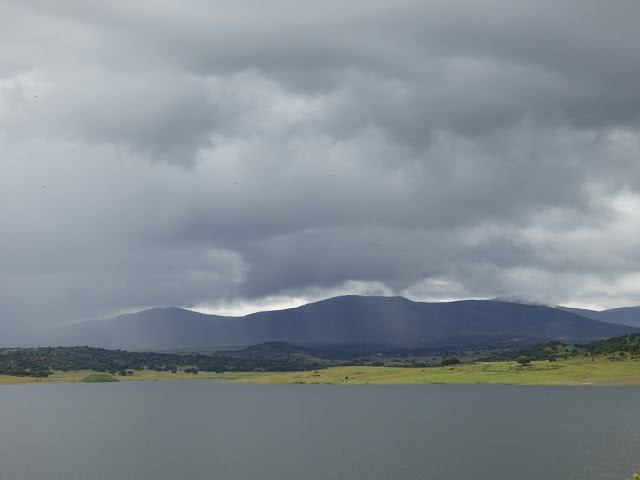Milestones
 |
| Alcollarín Reservoir (Martin Kelsey) |
A blustery late afternoon in mid-November and I pause to watch a large flock of small birds that zing like a wind-blown sheet pegged to a washing-line. They gather on the ovine-nibbled sward beside feed mangers in a small paddock populated by some ewes and lambs, under the shade of broad holm oaks. For no apparent cause, a "dread" sweeps across them and they retreat into the trees, like the sheet torn off the line. A minute or so later they calmly descend again, as if the sheet gently floats back to the ground. This woosh of panic and then calm happens every few minutes.
Most of them are sparrows, both House and their chunkier Spanish cousins. But there are also Chaffinches amongst them, and where there is a large winter flock of these, then there is always a chance of their northern counterparts: Bramblings. I settle down with my 'scope to pan across the groups of feeding birds once they are on the ground. It is frustrating - it seems that as soon as I start, they become airbourne again and disappear into the thick evergreen foliage above them. Patience: they drop down again and I start over again. As I hoped, I quite quickly find a Brambling amongst them, thanks to its amber shoulders and breast. Then another and another: at least three birds present. Most birders have a soft-spot for these finches, with their orangey-hues and narrow white rump, best glimpsed as they take off. Vast flocks of millions can sometimes gather in roosts in central Europe, in the extreme south-west of their wintering range such as in Extremadura, they are usually found in amongst Chaffinch flocks, only sometimes forming flocks of their own and rarely more than a hundred birds. Like many other boreal species, they are irruptive species, with numbers heading south and west varying greatly from year to year, depending on both their breeding success and the availability of autumn food (in the case of Bramblings beech mast). This unpredictabilty combined with their attractive appearance make them always a bird to treasure for many.
 |
| Brambling (Martin Kelsey) |
This sighting has special significance for me too, because with it I had reached a very personal milestone. Since 2014, when access became possible, I am made regular visits to the Alcollarín Reservoir. Lying just twenty or so minutes from home, it has become what we describe in birders' jargon, my local patch. I can nip there quickly for a morning or late afternoon visit, or for a whole day for that matter. Surrounded by dehesa woodland, much of it on granite outcrops and with low-lying grazing pasture as well, there is an alluring variety of habitats. Furthermore, it is great for birds all year round (I especially enjoy early mornings there in the dog days of summer). Like any good local patch, I always, always arrive there with a sense of nervous anticipation: what will it turn up next?
 |
| Alcollarín Reservoir in August 2014 (Martin Kelsey) |
Local patches for birders have had special significance during the pandemic. With travel further afield restricted, our local patches have literally helped us stay sane. During the tight lockdown in spring 2020 and during the period last winter when our municipality had closed its borders, my visits to Alcollarín were impossible. Those were the longest gaps in my coverage of the site, I yearned to return there and duly did, as soon as restrictions were lifted.
 |
| White-headed Duck (Martin Kelsey) |
The significance of the Bramblings were they were the 200th species of bird that I had personally recorded at Alcollarín. Over the years birding there, there have been numerous inforgettable moments (many shared with you in this blog). The first rarity I found there was White-headed Duck (in November 2014) which I have also recorded there in 2016 and 2018. It has chalked up Extremadura's first Smew and Ring-necked Ducks. I have seen an amazing 27 species of wader there, including Grey Phalarope. I am hoping one day to find a North American shorebird there, one day. I recall the spectacle of a flock of 13 juvenile Audouin's Gulls appearing out of an aseasonal thick fog on 26th July 2018. And standing on the dam before dawn in May this year, surrounded by singing Red-necked Nightjars. Local patches are above all about special moments, often experienced in the intimacy of one's own company.
 |
| Audouin's Gulls in a summer mist (Martin Kelsey) |
With a total of 219 species recorded at Alcollarín (yes, I have missed a few goodies there, especially during the municipal lockdown), it lies in 4th position of eBird "hotspots" for Extremadura. It is also one of the most important waterbodies in the region for wintering duck (in this year's waterbird census, I recorded over 11,000 birds there, including 6650 Shoveler). I count myself extremely fortunate indeed.



Comments